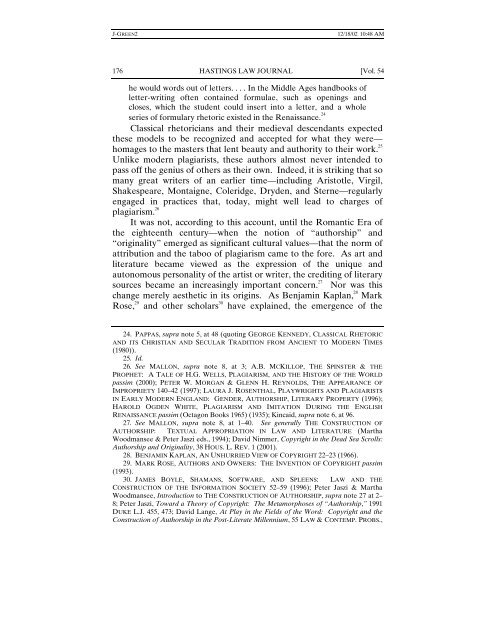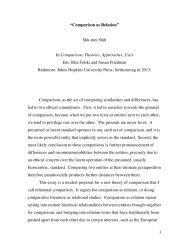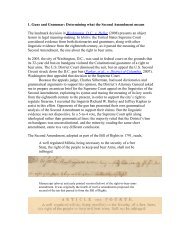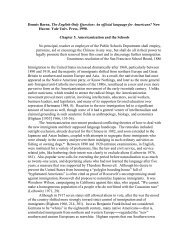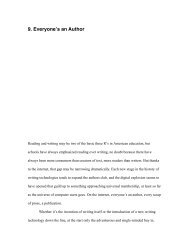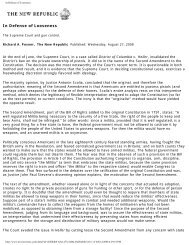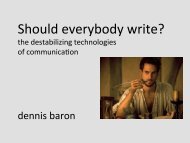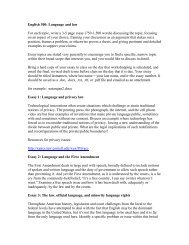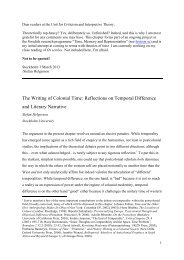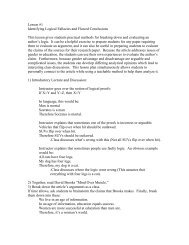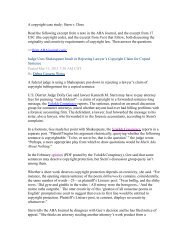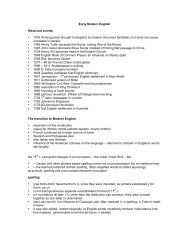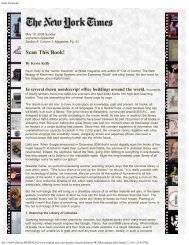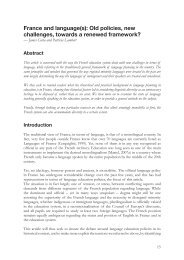Plagiarism, Norms, and the Limits of Theft Law: Some ... - English
Plagiarism, Norms, and the Limits of Theft Law: Some ... - English
Plagiarism, Norms, and the Limits of Theft Law: Some ... - English
You also want an ePaper? Increase the reach of your titles
YUMPU automatically turns print PDFs into web optimized ePapers that Google loves.
J-GREEN2 12/18/02 10:48 AM<br />
176 HASTINGS LAW JOURNAL [Vol. 54<br />
he would words out <strong>of</strong> letters. . . . In <strong>the</strong> Middle Ages h<strong>and</strong>books <strong>of</strong><br />
letter-writing <strong>of</strong>ten contained formulae, such as openings <strong>and</strong><br />
closes, which <strong>the</strong> student could insert into a letter, <strong>and</strong> a whole<br />
series <strong>of</strong> formulary rhetoric existed in <strong>the</strong> Renaissance. 24<br />
Classical rhetoricians <strong>and</strong> <strong>the</strong>ir medieval descendants expected<br />
<strong>the</strong>se models to be recognized <strong>and</strong> accepted for what <strong>the</strong>y were—<br />
homages to <strong>the</strong> masters that lent beauty <strong>and</strong> authority to <strong>the</strong>ir work. 25<br />
Unlike modern plagiarists, <strong>the</strong>se authors almost never intended to<br />
pass <strong>of</strong>f <strong>the</strong> genius <strong>of</strong> o<strong>the</strong>rs as <strong>the</strong>ir own. Indeed, it is striking that so<br />
many great writers <strong>of</strong> an earlier time—including Aristotle, Virgil,<br />
Shakespeare, Montaigne, Coleridge, Dryden, <strong>and</strong> Sterne—regularly<br />
engaged in practices that, today, might well lead to charges <strong>of</strong><br />
plagiarism. 26<br />
It was not, according to this account, until <strong>the</strong> Romantic Era <strong>of</strong><br />
<strong>the</strong> eighteenth century—when <strong>the</strong> notion <strong>of</strong> “authorship” <strong>and</strong><br />
“originality” emerged as significant cultural values—that <strong>the</strong> norm <strong>of</strong><br />
attribution <strong>and</strong> <strong>the</strong> taboo <strong>of</strong> plagiarism came to <strong>the</strong> fore. As art <strong>and</strong><br />
literature became viewed as <strong>the</strong> expression <strong>of</strong> <strong>the</strong> unique <strong>and</strong><br />
autonomous personality <strong>of</strong> <strong>the</strong> artist or writer, <strong>the</strong> crediting <strong>of</strong> literary<br />
sources became an increasingly important concern. 27 Nor was this<br />
change merely aes<strong>the</strong>tic in its origins. As Benjamin Kaplan, 28 Mark<br />
Rose, 29 <strong>and</strong> o<strong>the</strong>r scholars 30 have explained, <strong>the</strong> emergence <strong>of</strong> <strong>the</strong><br />
24. PAPPAS, supra note 5, at 48 (quoting GEORGE KENNEDY, CLASSICAL RHETORIC<br />
AND ITS CHRISTIAN AND SECULAR TRADITION FROM ANCIENT TO MODERN TIMES<br />
(1980)).<br />
25. Id.<br />
26. See MALLON, supra note 8, at 3; A.B. MCKILLOP, THE SPINSTER & THE<br />
PROPHET: A TALE OF H.G. WELLS, PLAGIARISM, AND THE HISTORY OF THE WORLD<br />
passim (2000); PETER W. MORGAN & GLENN H. REYNOLDS, THE APPEARANCE OF<br />
IMPROPRIETY 140–42 (1997); LAURA J. ROSENTHAL, PLAYWRIGHTS AND PLAGIARISTS<br />
IN EARLY MODERN ENGLAND: GENDER, AUTHORSHIP, LITERARY PROPERTY (1996);<br />
HAROLD OGDEN WHITE, PLAGIARISM AND IMITATION DURING THE ENGLISH<br />
RENAISSANCE passim (Octagon Books 1965) (1935); Kincaid, supra note 6, at 96.<br />
27. See MALLON, supra note 8, at 1–40. See generally THE CONSTRUCTION OF<br />
AUTHORSHIP: TEXTUAL APPROPRIATION IN LAW AND LITERATURE (Martha<br />
Woodmansee & Peter Jaszi eds., 1994); David Nimmer, Copyright in <strong>the</strong> Dead Sea Scrolls:<br />
Authorship <strong>and</strong> Originality, 38 HOUS. L. REV. 1 (2001).<br />
28. BENJAMIN KAPLAN, AN UNHURRIED VIEW OF COPYRIGHT 22–23 (1966).<br />
29. MARK ROSE, AUTHORS AND OWNERS: THE INVENTION OF COPYRIGHT passim<br />
(1993).<br />
30. JAMES BOYLE, SHAMANS, SOFTWARE, AND SPLEENS: LAW AND THE<br />
CONSTRUCTION OF THE INFORMATION SOCIETY 52–59 (1996); Peter Jaszi & Martha<br />
Woodmansee, Introduction to THE CONSTRUCTION OF AUTHORSHIP, supra note 27 at 2–<br />
8; Peter Jaszi, Toward a Theory <strong>of</strong> Copyright: The Metamorphoses <strong>of</strong> “Authorship,” 1991<br />
DUKE L.J. 455, 473; David Lange, At Play in <strong>the</strong> Fields <strong>of</strong> <strong>the</strong> Word: Copyright <strong>and</strong> <strong>the</strong><br />
Construction <strong>of</strong> Authorship in <strong>the</strong> Post-Literate Millennium, 55 LAW & CONTEMP. PROBS.,


